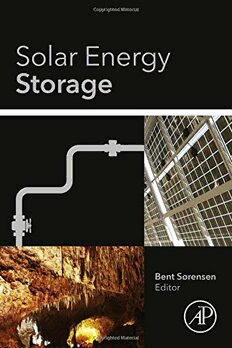
Solar Energy Storage PDF
Preview Solar Energy Storage
Solar Energy Storage Solar Energy Storage Edited by ø Bent S rensen Roskilde University, Denmark, Department ofEnvironmental, Socialand Spatial Change, http://energy.ruc.dk [email protected] AMSTERDAM (cid:129) BOSTON (cid:129) HEIDELBERG (cid:129) LONDON NEW YORK (cid:129) OXFORD (cid:129) PARIS (cid:129) SAN DIEGO SAN FRANCISCO (cid:129) SINGAPORE (cid:129) SYDNEY (cid:129) TOKYO Academic Press is an imprint of Elsevier AcademicPressisanimprintofElsevier 125LondonWall,London,EC2Y5AS,UK 525BStreet,Suite1800,SanDiego,CA92101–4495,USA 225WymanStreet,Waltham,MA02451,USA TheBoulevard,LangfordLane,Kidlington,OxfordOX51GB,UK ©2015ElsevierLtd.Allrightsreserved. Nopartofthispublicationmaybereproducedortransmittedinanyformorbyanymeans,electronic ormechanical,includingphotocopying,recording,oranyinformationstorageandretrievalsystem, withoutpermissioninwritingfromthepublisher.Detailsonhowtoseekpermission,further informationaboutthePublisher’spermissionspoliciesandourarrangementswithorganizations suchastheCopyrightClearanceCenterandtheCopyrightLicensingAgency,canbefoundatour website:www.elsevier.com/permissions. Thisbookandtheindividualcontributionscontainedinitareprotectedundercopyrightbythe Publisher(otherthanasmaybenotedherein). Notices Knowledgeandbestpracticeinthisfieldareconstantlychanging.Asnewresearchandexperience broadenourunderstanding,changesinresearchmethods,professionalpractices,ormedical treatmentmaybecomenecessary. Practitionersandresearchersmustalwaysrelyontheirownexperienceandknowledgeinevaluating andusinganyinformation,methods,compounds,orexperimentsdescribedherein.Inusingsuch informationormethodstheyshouldbemindfuloftheirownsafetyandthesafetyofothers,including partiesforwhomtheyhaveaprofessionalresponsibility. Tothefullestextentofthelaw,neitherthePublishernortheauthors,contributors,oreditors,assume anyliabilityforanyinjuryand/ordamagetopersonsorpropertyasamatterofproductsliability, negligenceorotherwise,orfromanyuseoroperationofanymethods,products,instructions,or ideascontainedinthematerialherein. BritishLibraryCataloguinginPublicationData AcataloguerecordforthisbookisavailablefromtheBritishLibrary LibraryofCongressCataloging-in-PublicationData AcatalogrecordforthisbookisavailablefromtheLibraryofCongress ISBN:978-0-12-409540-3 ForinformationonallAcademicPresspublications visitourwebsiteathttp://store.elsevier.com/ Contributors NaoyaAbe,DepartmentofInternationalDevelopmentEngineering,TokyoInstituteof Technology,Tokyo,Japan M.A.Baseer,MechanicalandAeronauticalEngineeringDepartment,Universityof Pretoria,Pretoria,SouthAfrica,andJubailIndustrialCollege,Jubail,SaudiArabia B.Bo¨cker,ChairforManagementSciencesandEnergyEconomics,University Duisburg-Essen,Essen,Germany AlexandreBeluco,InstitutodePesquisasHidra´ulicas(IPH),UniversidadeFederaldo RioGrandedoSul(UFRGS),PortoAlegre,Brazil JohannCaux,E´coled’Inge´nieursdel’Energie,l’Eauetl’Environnement(Ense3), InstitutPolytechniquedeGrenoble(INP),Grenoble,France PauloKroeffdeSouza,InstitutodePesquisasHidra´ulicas(IPH),UniversidadeFederal doRioGrandedoSul(UFRGS),PortoAlegre,Brazil R.Dhital,AlternativeEnergyPromotionCenter,MinistryofScience,Technologyand Environment,Lalitpur,Nepal YulongDing,SchoolofChemicalEngineering&BirminghamCentreofEnergy Storage,UniversityofBirmingham,Birmingham,UK Z.Glasnovic,UniversityofZagreb,Zagreb,Croatia JunichiroIshio,DepartmentofInternationalDevelopmentEngineering,TokyoInstitute ofTechnology,Tokyo,Japan J.K.Kaldellis,LabofSoftEnergyApplications&EnvironmentalProtection,TEIof Piraeus,Athens,Greece TeppeiKatatani,DepartmentofInternationalDevelopmentEngineering,Tokyo InstituteofTechnology,Tokyo,Japan NolwennLePierre`s,LOCIE,CNRSUMR5271-Universite´ deSavoie,Polytech Annecy-Chambe´ry,CampusScientifique,SavoieTechnolac,LeBourget-Du-Lac Cedex,France YongliangLi,SchoolofChemicalEngineering&BirminghamCentreofEnergy Storage,UniversityofBirmingham,Birmingham,UK ChuanpingLiu,DepartmentofThermalEngineering,UniversityofScienceand TechnologyBeijing,Beijing,China Fla´vioPohlmannLivi,InstitutoMensura,PortoAlegre,Brazil LingaiLuo,LaboratoiredeThermocine´tiquedeNantes(LTN-CNRSUMR6607), LaChantrerie,NantesCedex,France xiii xiv Contributors IainMacGill,SchoolofElectricalEngineeringandTelecommunications,Universityof NSW,Sydney,NSW,Australia B.Mainali,EnergyandClimateStudies,RoyalInstituteofTechnology,KTH, Stockholm,Sweden K.Margeta,UniversityofZagreb,Zagreb,Croatia RomanMarx,InstituteofThermodynamicsandThermalEngineering(ITW),Research andTestingCentreforThermalSolarSystems(TZS),UniversityofStuttgart, Stuttgart,Germany AshmoreMawire,DepartmentofPhysicsandElectronics,NorthwestUniversity, Mmabatho,SouthAfrica ToshihiroMukai,CentralResearchInstituteofElectricPowerIndustry,Tokyo,Japan F.Rahman,CenterforRefining&Petrochemicals,ResearchInstitute,andCenterof ResearchExcellenceinRenewableEnergy,KingFahdUniversityofPetroleum& Minerals,Dhahran,SaudiArabia S.Rehman,CenterforEngineeringResearch,ResearchInstitute,KingFahdUniversity ofPetroleumandMinerals,Dhahran,SaudiArabia BentSørensen,DepartmentofEnvironmental,SocialandSpatialChange,Roskilde University,Roskilde,Denmark B.Steffen,ChairforManagementSciencesandEnergyEconomics,University Duisburg-Essen,Essen,Germany ZeSun,NationalEngineeringResearchCentreforIntegratedUtilizationofSaltLake Resources,EastChinaUniversityofScienceandTechnology,Shanghai,China MurielWatt,SchoolofPVandRenewableEnergyEngineering,UniversityofNSW, Sydney,NSW,Australia C.Weber,ChairforManagementSciencesandEnergyEconomics,University Duisburg-Essen,Essen,Germany H.A.Zondag,DepartmentofMechanicalEngineering,EindhovenUniversityof Technology,Eindhoven,TheNetherlands Preface Theaimofthisbookistoprovideastate-of-the-artdescriptionanddiscussionof theenergystorageissuesrelevantformostsolarenergysystems,particularlyfor situationsinwhichsolarenergyconstitutesmorethanamarginalfractionofthe totalenergysupply.Thedispositionofthematerialisasfollows.First,anover- viewofsolarsystemswithenergystorageisgiven,separatelyforsolarelectric- ity and solar thermal systems. Then, two more detailed presentations of solar storageoptionsaregiven,withemphasisonsuitabilityforparticulargeograph- icalandthusclimaticsituations,againdividedbetweenelectricpowerandheat applications.Afterthatcomethreespecificdiscussionsofsorptionheatstores andhydroelectricstoragesystems,includingcomparisonwithbatterystorage. Following these technology chapters, two chapters describe the economic status of solar storage facilities, from both a theoretical and a practical point ofview.Advantagesofsolarandotherrenewableenergysystemsmaybemod- estwhenlookingonlyatdirecteconomicviability,butthetwonextchaptersadd adiscussionofindirecteconomicfactorsthatinviteemploymentofafulllife- cycleanalysisandassessment.Thesefactorsincludeenvironmentalconcernsas wellassocialconcernsinfluencingthechoicesmadebysocietiesandindividual consumers. Rounding up the book’s survey, three chapters present case studies of the particular challenges that solar systems meet on remote islands and locations far from existing power grids, looking at cooking as well as basic electricity demands for communication, education, and local machinery. The alternative for economic comparison in these cases would be grid extension, over land orbyseacables.Thefunctioningoflocalsolarsystemswithstorageisanalyzed bothforindividualsystemsandforunitsconnectedintoamini-grid,exploring the mini-grid’spossible advantage byreducingstorage requirements. Thesubjectstreatedinthebookaretimelybecausesolartechnologieshave recently experienced a substantial cost reduction that makes it worthwhile to explore barriers to reaching a sizable fraction of energy supply under the dif- ferentconditionsprevailingindifferentpartsoftheworld,andwhenpossible to devise solutions to overcome these barriers, even in cases where increased solarenergypenetrationimpliesaugmentedneedforenergystoragesolutions. BentSørensen xv Chapter 1 Introduction and Overview Bent Sørensen DepartmentofEnvironmental,SocialandSpatialChange,RoskildeUniversity,Roskilde,Denmark Forsomefivedecades,thecostofsolarphotovoltaicsystemshasdeclinedfrom spaceindustrylevelstowardaffordabilityforindividualconsumers,helpedby theoccasionalgovernmentsubsidyprogramsineffectinonecountryoranother foralimitedtime.Thecurrentdecadeisseeingsolarpanelpricesbeingincreas- inglyacceptedbycustomerswithoutsubsidies;consequently,arapidaugmen- tation of installed capacity has taken place (IEA, 2014). A similar but less dramaticdevelopmenthashappenedforsolarthermalsystems,havingbecome commonfirstashotwaterproviders,andnowalsoforspaceheatingintheinter- mediatelatituderegionsthatneedwinterspaceheatingbutarestillcloseenough totheequatortohaveadecentnumberofsunshinehoursinwinter.Thesedevel- opmentsmakeittimelytothinkoftheobstaclesforsolarenergytechniquesto eventually become a major component in our energy systems. Among these problems, intermittency seems to be the most important. Either solar energy shouldbecombinedwithotherenergysourcescapableofcomplementingsup- plyduringdarkhours,ordevicesforstoringandregeneratingenergymustbe partofthesolarenergysystem.Thebestsolutionisprobablyacombinationof includingenergysourceswithadifferentdeliveryprofile,havingenergystor- ageavailable,andtakingadvantageofenergytransmissionandtradepossibil- ities,aswellasanyloadmanagementoptionsthatwouldbeacceptabletothe energy users. Thisbookfocusesonenergystoressuitableforintegrationintosolarenergy systems for delivering electric orthermal powertothe end users. The combi- nationofallthemethodshintedataboveisthesubjectofanotherrecentbookon energyintermittency,beingthefirsttocharttheglobalintermittencyproblem andtolookatalltheoptionsforasustainableenergysystembasedonseveral renewableenergysources,storage,trade,anddemandmanagement,including thepossiblesynergiesofferedbycombiningthesolutionsfordealingwithinter- mittency (Sørensen, 2014). Inlookingspecificallyatenergystorage,twodistinctareasofapplicationfor solarenergycanbediscerned.Oneisthatofstoragesystemsaimedathandling the obvious day-to-night storage requirement, caused by human activities not SolarEnergyStorage.http://dx.doi.org/10.1016/B978-0-12-409540-3.00001-3 ©2015ElsevierLtd.Allrightsreserved. 1 2 SolarEnergyStorage being restricted to hours of high solar radiation input. The second area is the seasonalstoragethatwillstoreenergygeneratedinsummeroradjacentperiods for use in winter at mid or high latitudes. Electricity demand varies over the year, with differences between different types of societies, but it is still fairly evenlydistributedovertheyear.Thisisatleasttruecomparedwiththesituation forsolarspaceheating,wherethedemandisobviouslyinverselycorrelatedwith solar supply, as soon as one departs substantially from the equator. Between these two extremes are the intermittency problems caused by passage of weathersystems,withcloudsandotheratmosphericobstaclestoreceivingsolar radiationattheEarth’ssurface.Ifsolarintermittencyistobehandledbyenergy stores, the storage systems must comprise units operating on diurnal, weekly, andseasonal time scales. Several of the energy stores currently developed and ready for use are directed at shorter periods of storage. The shortest storage periods, related to fluctuations of solar energy production over seconds or minutes, are usually unimportant for heating purposes; for electric power production, any grid- connected system with some kilometer spacing between solar panels will smoothoutsuchsmall-scalefluctuations.Forisolatedsystems,short-termfluc- tuationsmaybehandledbyaddingcapacitorstoresorflywheels,buteveninthis casetheimportanceisdeclining,becausethepresentgenerationofelectricity- usingequipmentiseithernotverysensitivetomodestvariationsinvoltageor frequency (if AC), or it has built-in short-term storage, usually inthe form of supercapacitors. Moving on to storage levels capable of handling the variations in solar energyproductionduringtheday,orthenighttimenonproduction,therelevant storageperiodswouldbe12-18h,consideringthatthereducedsolarradiation awayfromnoontimemaynotcorrelatewiththevariationsindemand.Storesof interest for this length of drawing time (in most cases also with a prolonged store-filling time) include various types of batteries, compressed air under- groundstores,pumpedhydro,aswellasfuelcontainers,whichinarenewable energyscenariowouldhavetocontainfuelsthatcanbecreatedfrombiomassor electricity(suchascertainbiofuelsandhydrogen).Arangeofsuchstoreswill bedescribed andevaluated inthe following chapters. Finally,forstoragelastingmorethanaweek(asneededduringepisodesof heavycloudcoverorextendedrainyperiods)andseasonalstorage (neededat latitudes with a substantial difference between summer and winter levels of incomingsolarradiation,andforheatalsobecauseoftemperature-relatedvar- iations in space-heating demands), there are fewer storage options available. Economic considerations rule out storage in containers as compressed air andprobablyalsoinbatteries,duetothecostbeingproportionaltotheamount ofenergystored.Pumpedhydrowillremainanoptionaslongastheupperres- ervoirislargeenough,andsowillfuelstorageifcontainerscanbereplacedby inexpensive underground cavity options. Such cavities can be found in aban- donedoilorgaswells,ortheycanbeformedincertainaquifersandgeological IntroductionandOverviewChapter 1 3 Surface Salt Permeable Cavity or Impermeable layer fractured layer layer (”caprock”) Cavity Water (a) (b) (c) FIGURE1.1 Typesofundergroundgasstores(forhydrogen,naturalgas,orairatvariouslevelsof compression):(a)storageinsaltdomes,optionallyusingcanistersifcavitywallsaretooporousor donotacceptliners;(b)drilledrockcavitiesorabandonedwells,possiblywithacompensatingsur- facereservoir;and(c)storageinanupwardbendofanaquiferrunningbetweennonporouslayers (e.g.,ofclay).(FromSørensen(2010),usedwithpermissionfromElsevier.) saltdeposits(Figure1.1).Bothaquiferbendsofferingsectionssuitablefordis- placingwaterbyagasandslowlywashedoutcavitiesinsaltdomesareinsub- stantialusetodayfornaturalgasstorage,suchasthestrategicstorescommonin someEuropeancountries,holding4-6monthsofgasdemandasabufferagainst disruptions caused by major rupture of undersea gas supply pipelines or by politicaldelivery blockades (Russian gas). Inconnectionwithsolarpowerandothersourcesofpowergeneratedbyvar- iablerenewableenergyflows,therelevantgastostorewouldbehydrogen.This isindependentofthefateofthecurrenteffortstodevelophydrogenfuelcellsfor the automotive sector, because the solar-produced hydrogen stored could be usedtoregenerateelectricitybyconventionalgasturbines,alow-costtechnol- ogyavailabletoday.Bytheway,oneshouldrememberthatfuelcellsandelec- trolyzers are the same thing: all fuel cells can be used in reversed mode to generatehydrogenfromelectricity.Currently,commonhigh-efficiencyelectro- lyzersarealkalinefuelcells,butalsotheproton-exchangemembranefuelcells relevantforthetransportationsectororthesolid-oxidefuelcellsaimedatelec- tricpowersectorapplicationsmaybeoperatedinreversemodeaselectrolyzers (electricity tohydrogen) (Sørensen, 2011). Theundergroundhydrogenstoresseemingtoofferthemostviablesolution forlongertimestorageofsolarelectricityareoftenmissingfromthescientific literatureonstoresforrenewableenergysystems,buthaveinrecentyearstaken 4 SolarEnergyStorage the foreground in national and regional planning studies both in the United States(Lordetal.,2011)andintheEuropeanUnion(Simo´netal.,2014).Here, they are dealt with inthe chapter on environmental issues. As regards thermal energy storage, the most common technology is heat capacitystorageusingwater,eitherinconnectionwithindividualbuildingsolar installationsorinacentrallocationfordistrictheatingbasedonsolarcollector arrays. Alternatives using gravel or other materials have been tested, as have phase change materials, but without pointing to any clear winners. In many locations,thebestoptionforcoveringwinterspaceloadsintheabsenceofsuf- ficientsolarenergycollectionistouserenewableelectricityorelectricityfrom storesthroughheatpumps(Sørensen,2014).Aselectionofsuchsystemsisdis- cussed inthe chapters below. REFERENCES IEA, 2014. Trends 2014 in photovoltaic applications. PVPS report T1-25:2014. International EnergyAgency,Paris. Lord,A.,Kobos,P.,Klise,G.,Borns,D.,2011.Alifecyclecostanalysisframeworkforgeological storage of hydrogen: a user’s tool. Report SAND2011-6221. Sandia National Laboratories, Albuquerque/Livermore. Simo´n,J.,etal.,2014.Assessmentofthepotential,theactorsandrelevantbusinesscasesforlarge scale and long term storage of renewable electricity by hydrogen underground storage in Europe. Final report D 6.3 from the European Commission funded project “HyUnder”, Zaragosa. Sørensen,B.,2010.RenewableEnergy—ItsPhysics,Engineering,EnvironmentalImpacts,Eco- nomics&Planning.fourthed.AcademicPress/Elsevier,Burlington(5theditioncurrentlyin preparation). Sørensen,B.,2011.HydrogenandFuelCells,seconded.AcademicPress/Elsevier,Burlington. Sørensen,B.,2014.EnergyIntermittency.CRCPress,Taylor&Francis,BatonRouge.
